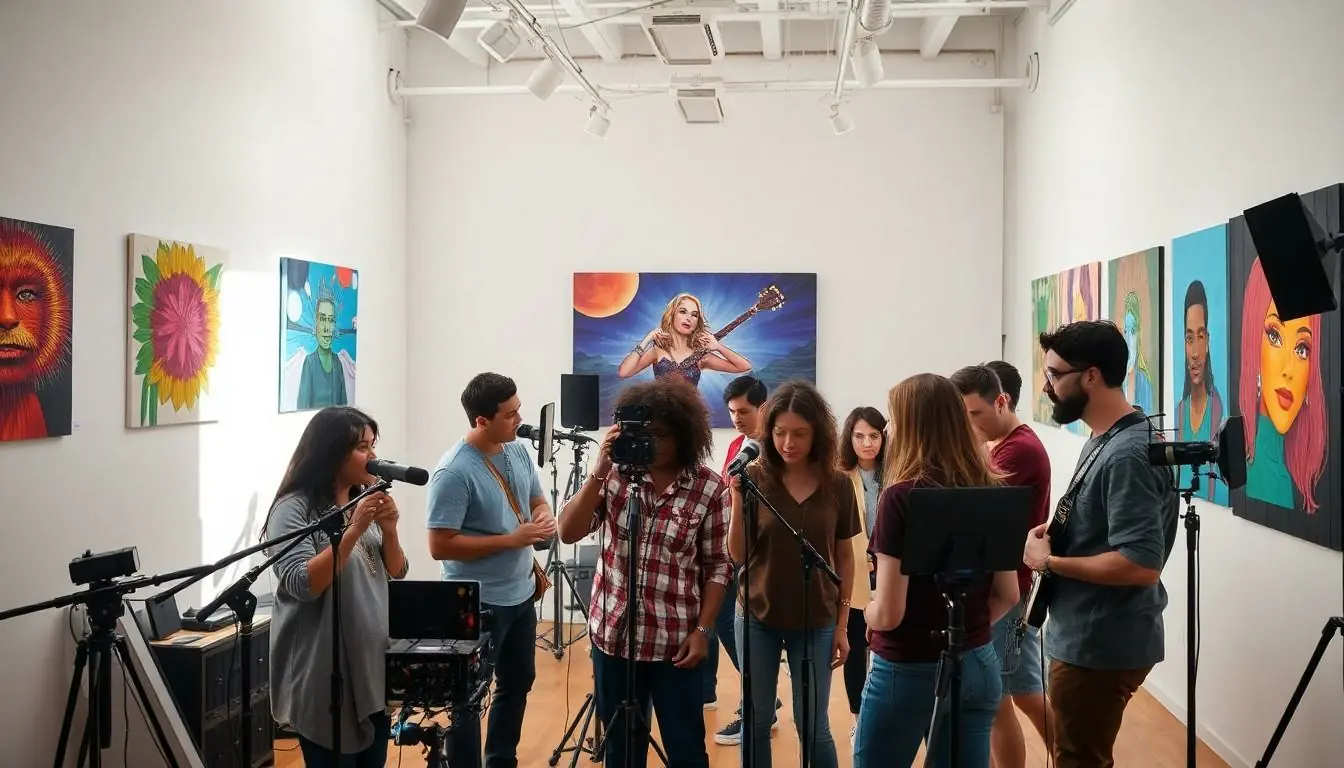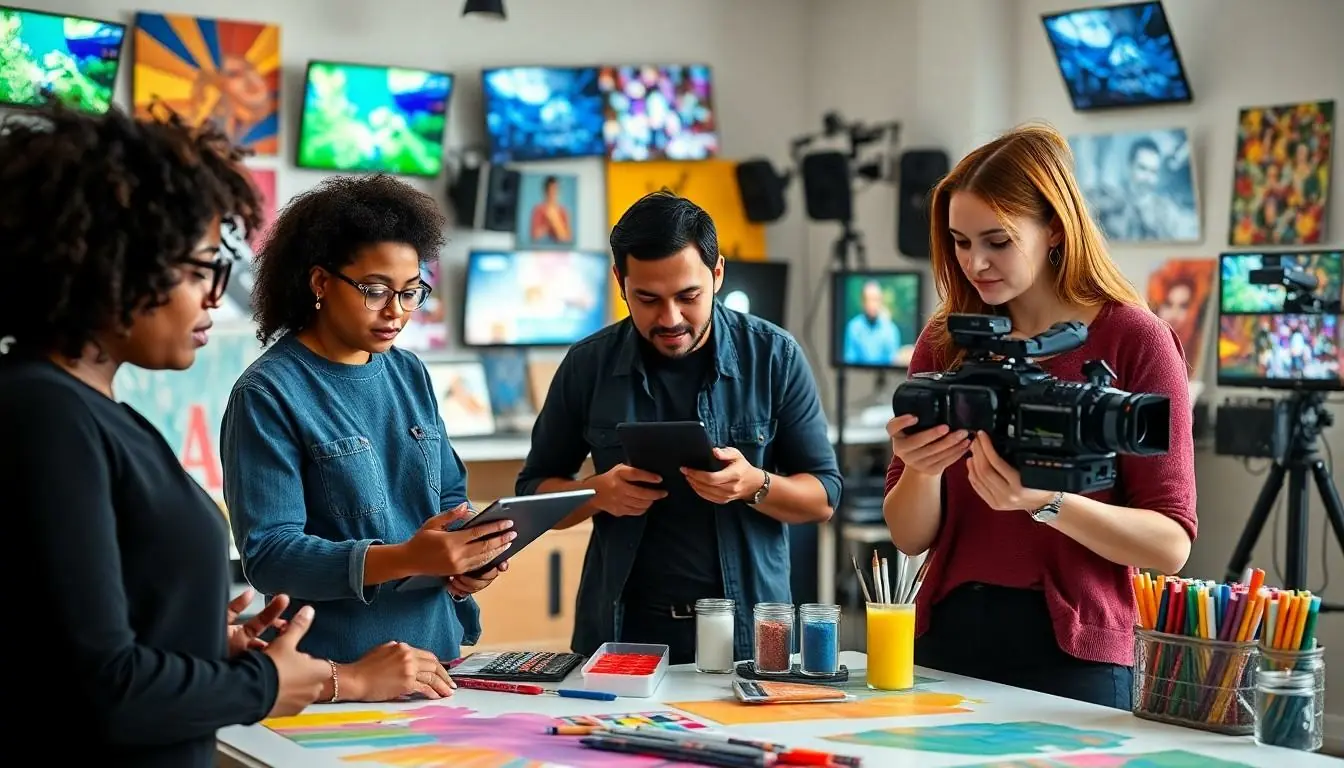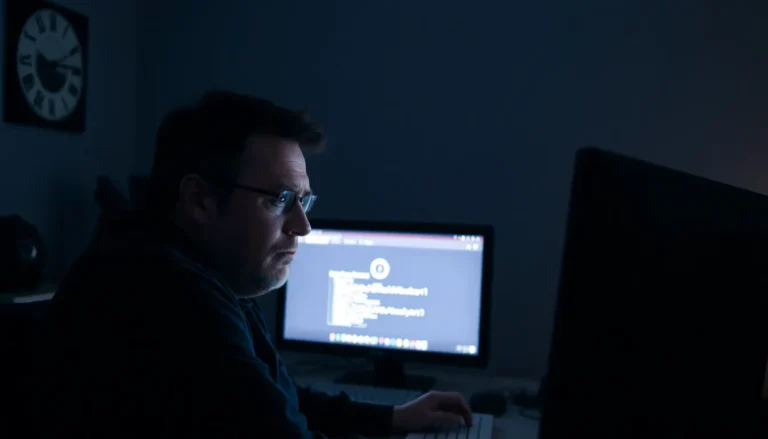Table of Contents
ToggleIn today’s tech-savvy world, arts audio/video technology and communications are reshaping the way creativity flows. Imagine capturing the perfect moment with just a click or sharing your masterpiece with the world in an instant. Sounds dreamy, right? But hold on! With great power comes great responsibility—or at least a few hiccups along the way.
While these innovations can elevate artistic expression, they also come with their fair share of challenges. From the overwhelming array of tools to the potential for technical glitches, navigating this digital landscape can feel like trying to find Wi-Fi in a remote cabin. So, let’s dive into the pros and cons of this vibrant realm, where creativity meets technology, and discover if it’s worth the ride.
Overview of Arts Audio/Video Technology and Communications
Arts audio/video technology enhances creative expression by providing various tools for artists. This technology allows for seamless production and distribution of artistic content. Artists can capture high-quality audio and video, enabling improved audience engagement. Multiple platforms facilitate sharing, significantly broadening reach.
Communication tools, including social media, elevate visibility and encourage collaboration. Artists actively use video conferencing apps for real-time discussions, which fosters community involvement. Educational resources are widely available, helping individuals learn new techniques and best practices.
Despite these advantages, challenges persist. An overwhelming number of available tools can confuse users, leading to frustration. Technical issues may also arise, disrupting projects and causing delays. Moreover, exposure to an extensive amount of creative work can intimidate new artists, discouraging participation.
Balancing creativity with technology remains crucial. Artists often navigate the fine line between using technology as a tool and feeling overwhelmed by it. This interplay shapes the landscape of arts audio/video technology and its impact on communications. Awareness of both benefits and drawbacks allows artists to leverage technology effectively while minimizing its downsides.
Understanding these dynamics ensures artists can truly benefit from the advancements in audio/video technology and communication. Embracing these developments promotes creativity while simultaneously addressing potential obstacles.
Pros of Arts Audio/Video Technology

Arts audio and video technology brings numerous advantages to creative endeavors. Enhanced creative expression stands out among these benefits.
Enhanced Creative Expression
Artists gain access to sophisticated tools that capture high-quality audio and video. Such technologies allow for innovative storytelling and unique presentation styles. Capturing intricate details becomes effortless, enabling artists to convey their vision more effectively. With these advancements, creativity flourishes as artists explore new methods of expression beyond traditional mediums.
Expanded Reach and Accessibility
Reaching wider audiences becomes simpler with advanced audio and video technology. Artists can share their work on multiple platforms, including social media and streaming services. Accessibility increases as audiences experience art through various formats, accommodating diverse preferences. These technologies break geographical barriers, allowing artists to connect with viewers around the globe.
Improved Collaboration and Networking
Collaboration thrives through modern communication tools available in the arts. Artists connect in real-time using video conferencing and online platforms. Networking opportunities expand significantly as individuals create partnerships across disciplines. These interactions foster a supportive community that encourages creativity and innovation. Access to collaborative tools enhances artistic projects, leading to richer, more diverse outcomes.
Cons of Arts Audio/Video Technology
Arts audio/video technology presents several challenges that can impact creators. These drawbacks often complicate the artistic process and hinder creativity.
High Costs and Financial Barriers
Investing in professional audio and video equipment comes with significant financial implications. Top-tier cameras, microphones, and editing software can cost thousands of dollars. For many artists, these high expenditures create barriers to entry in the digital landscape. Individuals pursuing artistic careers may find it difficult to secure essential tools without substantial financial backing. While some affordable options exist, they often compromise quality, impacting overall artistic output. Consequently, talented individuals may be excluded from the creative realm due to lack of funds.
Potential for Over-Saturation
Digital platforms allow artists to share their work with ease, resulting in an influx of content available online. This abundance can lead to over-saturation, making it challenging for individual artists to stand out. Although diverse creativity flourishes, audiences may feel overwhelmed by the sheer volume of artistic expressions. Many creators struggle to gain visibility among a crowded marketplace. This situation can diminish motivation, causing artists to question the value of their work. As fresh voices emerge constantly, maintaining a distinctive presence becomes increasingly difficult.
Dependence on Technology
Relying heavily on technology can create issues for artists in various ways. Technical difficulties often arise, potentially derailing projects and causing frustration. Inconsistent internet access can disrupt communication and collaboration, hindering progress. Artists may also find themselves distracted by potential technical enhancements rather than focusing on the creative process. Relying on specific platforms can lead to a lack of versatility, limiting an artist’s ability to adapt to alternative mediums. Addressing these dependency challenges requires a mindful approach to balancing creativity and technological reliance.
Balancing the Pros and Cons
Balancing the pros and cons of arts audio/video technology is crucial for artists navigating today’s creative landscape. Enhanced creative expression stands out as a primary advantage; artists can utilize sophisticated tools to produce high-quality audio and video. These tools also expand reach and accessibility, allowing creators to share their works globally without geographical restrictions.
Collaboration benefits significantly from modern communication technology. Artists connect in real-time through platforms such as social media and video conferencing, fostering networking opportunities that were previously unavailable. Educational resources facilitate skill development, enabling individuals to learn and refine their techniques effectively.
Challenges do exist alongside these benefits. An overwhelming number of available tools can confuse users, especially those new to the creative field. Many artists experience intimidation from the sheer volume of creative work shared online, which may discourage participation.
Financial barriers constitute another significant drawback. The high costs associated with professional-grade equipment can exclude talented individuals from pursuing their artistic ambitions. In addition, the ease of sharing online sometimes leads to content over-saturation, making it more difficult for artists to gain visibility.
Reliance on technology poses its own set of issues. Technical difficulties can disrupt creative processes, while distractions from constant connectivity can hinder focus. Striking a balance between leveraging technology and staying true to creative instincts is essential. By addressing both the advantages and challenges, artists can make informed decisions that enhance their creative journeys.
Navigating the world of arts audio/video technology and communications presents both exciting opportunities and significant challenges. Artists can harness advanced tools to elevate their creative expression and reach wider audiences. The ability to collaborate and connect in real-time fosters a vibrant community that thrives on innovation.
However the risks of technical issues and financial barriers can hinder progress. The overwhelming number of available tools may discourage new artists from fully engaging with their craft. Striking a balance between embracing technology and nurturing creativity is essential. By doing so artists can ensure their artistic journeys remain fulfilling and impactful in an ever-evolving digital landscape.






